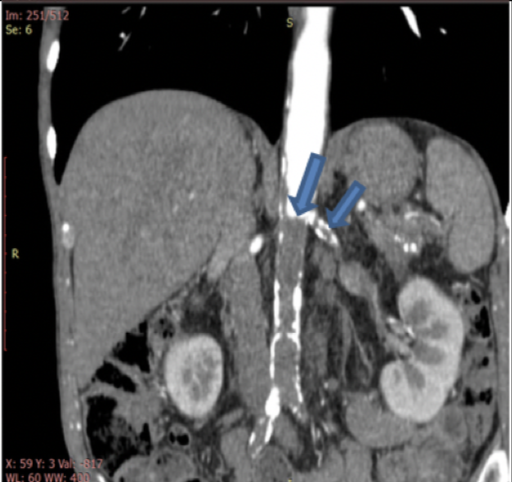
Julius Vidikas1, Viktorija Vitkutė2, Paulina Tekoriutė2, Iveta Idzelytė2, Tadas Adomavičius3
1Department of Radiology of Lithuanian University of Health Sciences Kaunas, Lithuania.
2Lithuanian University of Health Sciences, Academy of Medicine, Faculty of Medicine, Kaunas, Lithuania
3Vilnius University Hospital, Santaros Clinics
Abstract
Background: Leriche syndrome, also known as Aortoiliac Occlusive Disease (AOD), is a rare and extremely severe condition characterized by a clinical triad – claudication, impotence and decreased or absent femoral pulses. It is the disease caused by embolism or atherosclerotic lesion of the aortoiliac arteries. The main risk factors for Leriche syndrome include smoking, hypertension, hyperlipidemia, diabetes mellitus, chronic renal insufficiency and hypercoagulopathy. A duplex ultrasound may be used for selective diagnosis of the disease, but computed tomography or magnetic resonance angiography must be performed to confirm the disease. Two main methods are used to treat Leriche syndrome – aortobifemoral bypass and aortoiliac endarterectomy.
Aim: to present a clinical case of Leriche syndrome diagnosed in the Hospital of Lithuanian University of Health Sciences Kauno Klinikos, review the latest scientific literature, introduce clinical signs, diagnosis and treatment options of this rare disease for doctors of various specialties.
Methods: A review of the literature using the Medline (PubMed) database was performed. Publications, researching the problem of Lerich syndrome, were selected and a clinical case of AOD (Leriche syndrome) was presented.
Conclusion: Leriche syndrome is an uncommon and life-threatening variant of peripheral artery disease that can damage various areas of the abdominal aorta and iliac arteries, disturb inflow to the pelvis and lower extremities and cause characteristic clinical symptoms. Although the worldwide incidence of the disease is only 0.15%, the mortality rate is high and reaches up to 75%, so it is important for professionals in various fields to recognize the disease and provide appropriate treatment as soon as it is possible.
Keywords: Leriche syndrome, atherosclerosis, aortobifemoral bypass, aortoiliac endarterectomy.